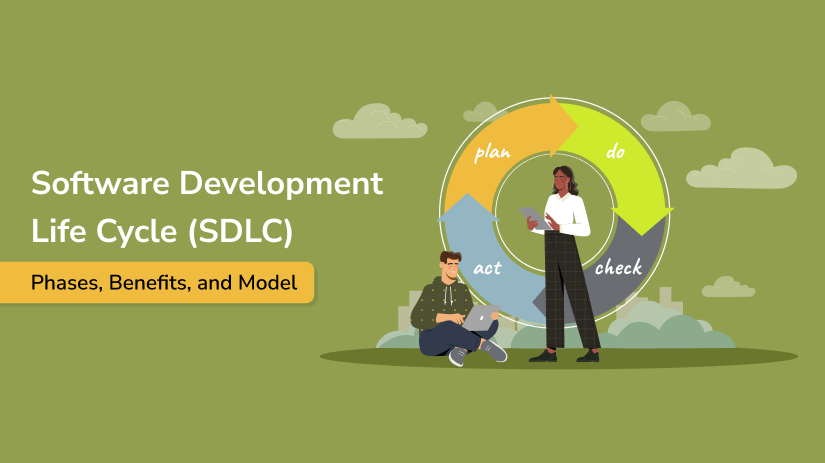Software development requires proper planning, precise execution, and good management due to its complexity and dynamic nature of process.
The Software Development Life Cycle (SDLC) is a proven systematic framework that gives perfect guidance for high-quality software development.
In this blog, we are going to learn everything about SDLC including every phase of the development cycle, various methodologies, several benefits, and the popular models used in the software development industry.
Connect with us for Fintech Development Needs
Trusted by companies like Plaid, Yodlee, Codat.
What is the Software Development Life Cycle (SDLC)?
The software development life cycle is nothing but a structured approach to the software development process that defines a set of multiple stages such as design, development, testing, deployment, and maintenance of software systems.
The primary aim of the software development life cycle is to create software that meets or exceeds the client’s expectations in a given time and budget having high quality.
Let’s see the top 7 phases of the software development life cycle.
7 Phases of SDLC
Software Development Life Cycle (SDLC) is divided into the top 7 phases in which your software will develop successfully. Here we have explained all the 7 phases of SDLC for better understanding. Have a look:
1. Planning
Project Planning is the first phase of the software development life cycle where you have to collect all the business needs from your client or stakeholders.
This is the phase when you have to evaluate the feasibility of developing a product, revenue capabilities, production cost, the end-user’s needs, etc.
It’s all about filtering what to create, what not to create, and what to create first. For this, you can use a feature prioritization framework that takes into account the value of the software and update, the cost, the period of development, and other factors.
Once you have the final details of the software project that says everything has been planned accordingly business and stakeholder goals, feasible to develop, and addresses user requirements, then you can take the next step for the second phase of the SDLC.
2. Analysis | Requirements Gathering
This is the second phase of the software development life cycle (SDLC) in which you have to strictly focus on gathering, analyzing, and documenting the requirements of your clients and stakeholders.
In this stage, software product engineering teams communicate with customers to collect and clarify the specific features and functionalities of the developing software. This process involves meticulous requirement analysis to ensure that the collected information is clear, complete, and feasible.
Prototyping may also be utilized to provide stakeholders with a tangible representation of the system. The Analysis phase lays the groundwork for subsequent development stages by delivering a refined set of requirements, a clear system architecture, and a comprehensive understanding of the software project’s feasibility.
Connect with us for Fintech Development Needs
Trusted by companies like Plaid, Yodlee, Codat.
3. Design
The design phase involves translating the initial plan and vision into a comprehensive Software Design Document (SDD).
This document encompasses elements such as system design, programming language, templates, platform specifications, and security measures for the application.
Additionally, this phase allows for the creation of flowcharts illustrating how the software responds to user actions.
Typically, the design phase incorporates the development of a prototype model. Crafting a pre-production version of the product provides the team with a visual representation, enabling them to make adjustments without the need for extensive code rewriting.
4. Implementation (Coding) | Development
In the Software Development Life Cycle (SDLC), the Implementation or Coding phase is a critical stage where the actual development of the software takes place.
During this phase, the design specifications outlined in the previous stages are translated into executable code by developers. They write the source code, following coding standards and best practices, to create the functionalities and features specified in the design documents.
This phase is characterized by the creation of algorithms, data structures, and the overall logic required to achieve the software’s objectives. Developers use programming languages, tools, and frameworks to bring the design to life.
The development phase is responsible for creating user-friendly software such as fundraising software, eCommerce software, account management software, and so on.
Rigorous testing and debugging are essential during this phase to identify and rectify any errors or bugs in the code. The successful completion of the Implementation phase sets the foundation for subsequent testing, deployment, and maintenance phases in the SDLC.
5. Testing
Before releasing the software product to the production environment, it is crucial to have the quality assurance team conduct validation testing to ensure its proper functionality and adherence to intended purposes.
This testing phase is instrumental in identifying and addressing significant user experience and security issues.
In certain instances, software testing can take place in a simulated environment, and simpler tests can be automated. The following types of testing should be undertaken during this phase:
- Performance testing: Evaluate the software’s speed and scalability under various conditions.
- Functional testing: Validates that the software meets specified requirements.
- Security testing: Identifies potential vulnerabilities and weaknesses.
- Unit testing: Examines individual units or components of the software.
- Usability testing: Assesses the software’s user interface and overall user experience.
- Acceptance testing: Also known as end-user testing, beta testing, application testing, or field testing, this final stage ensures that the software product delivers on its promises.
6. Deployment
In the Software Development Life Cycle (SDLC), the Deployment phase marks the culmination of the development process as the software is released for actual use.
This stage involves the careful transition of the developed application from a testing or staging environment to a live production environment where end-users can access and utilize it.
Deployment encompasses activities such as installing the software, configuring it to work with existing systems, and ensuring that all dependencies are met.
Thorough testing is crucial during this phase to guarantee that the software functions as intended and does not disrupt existing operations.
Additionally, deployment may involve tasks like data migration, setting up user accounts, and providing necessary documentation for end-users.
Successful deployment is a key milestone, signifying that the software is ready for use and has met the specified requirements and quality standards outlined in the earlier stages of the SDLC.
7. Maintenance and Support
The Maintenance phase is a stage dedicated to the ongoing support and improvement of the deployed software.
Once the application is live, maintenance becomes crucial for addressing any issues that may arise, such as bugs, security vulnerabilities, or performance concerns.
This phase also involves making enhancements or updates to the software to adapt it to changing requirements, technologies, or user needs.
Maintenance activities may include debugging, patching, and releasing updates or new versions of the software.
Additionally, user feedback is considered during this phase to identify areas for improvement or features that could enhance the user experience.
Maintenance ensures the longevity and reliability of the software, contributing to its continued success and usability in the long term.
In the next section, we will explore the benefits of embracing the software development life cycle.
Connect with us for Fintech Development Needs
Trusted by companies like Plaid, Yodlee, Codat.
Top 10 Benefits of Software Development Life Cycle
The Software Development Life Cycle (SDLC) is a systematic process for planning, creating, testing, deploying, and maintaining software. It provides a structured framework for software development, ensuring that the development process is organized and efficient.
Here are some of the key benefits of using SDLC:
1. Structured Approach
SDLC provides a systematic and structured approach to software development. It divides the entire process into distinct phases, making it easier to manage and control the development process.
2. Better Planning
SDLC involves comprehensive planning at the beginning of the project. This includes defining the scope, objectives, timelines, and resources required. Proper planning helps in setting realistic expectations and avoiding potential issues.
3. Risk Management
SDLC incorporates risk management strategies at various stages. Identifying potential risks early in the development process allows teams to address them proactively, reducing the likelihood of project failure or delays.
4. Quality Assurance
SDLC emphasizes the importance of testing and quality assurance throughout the development life cycle. This ensures that the software meets the specified requirements and is free of critical bugs or errors.
5. Improved Collaboration
SDLC encourages collaboration among cross-functional teams, including developers, testers, project managers, and stakeholders. This collaborative approach fosters effective communication and coordination among team members.
6. Traceability
SDLC facilitates traceability by documenting each phase of the development process. This documentation helps in tracking changes, understanding the development history, and ensuring that the final product aligns with the initial requirements.
7. Cost Control
By defining clear objectives and estimating resource requirements during the planning phase, SDLC helps in controlling development costs. This reduces the likelihood of budget overruns and ensures that the project stays within financial constraints.
8. Enhanced Productivity
The structured approach of SDLC helps in optimizing resource utilization and improving team productivity. Clearly defined roles and responsibilities contribute to a more efficient development process.
9. Customer Satisfaction
SDLC aims to deliver a product that meets or exceeds customer expectations. By involving stakeholders throughout the development process and incorporating their feedback, the likelihood of delivering a successful product that satisfies users is increased.
10. Maintainability and Scalability
SDLC considers the long-term maintenance and scalability of the software. It helps in creating software that is easy to maintain, update, and scale as business requirements evolve.
Popular SDLC Models
Software Development Life Cycle (SDLC) models are frameworks that guide the process of developing software from its initial concept to its deployment and maintenance. Several popular SDLC models are widely used in the software industry. Here are some of them:
Waterfall Model
- Sequential and linear approach.
- Progresses through defined phases such as requirements, design, implementation, testing, deployment, and maintenance.
- Each phase must be completed before moving to the next.
Iterative Model
- Involves repetitive cycles of the development process.
- Each iteration results in an improved version of the software.
- Allows for flexibility and refinement based on feedback.
Incremental Model
- Divide the software development process into small, manageable parts or increments.
- Each increment delivers a portion of the complete system.
- Integration of increments leads to the final product.
Spiral Model
- Combines the iterative and incremental development models.
- Progresses through a series of spirals, each representing a phase in the software development life cycle.
- Incorporates risk analysis and allows for changes during development.
Agile Model
- Emphasizes flexibility, collaboration, and customer feedback.
- Iterative and incremental development.
- Focuses on delivering a minimum viable product (MVP) quickly and then refining it through successive iterations.
Final Words
The Software Development Life Cycle is a crucial framework that guides the development of reliable, high-quality software.
By understanding the phases, methodologies, benefits, and models associated with SDLC, software development teams can navigate the complexities of the development process more effectively, ultimately delivering successful projects that meet or exceed client expectations.
As the software industry continues to evolve, the importance of SDLC in ensuring successful project outcomes remains paramount.
Happy SDLC!!!!
Frequently Asked Questions (FAQs)
1. What is the Software Development Life Cycle (SDLC)?
SDLC is a systematic process for planning, creating, testing, deploying, and maintaining software. It provides a structured framework to ensure that the software meets quality standards and user requirements.
2. What are the main phases of SDLC?
The typical phases of SDLC include Planning, Requirements, Design, Implementation, Testing, Deployment, and Maintenance. Each phase serves a specific purpose in the software development process.
3. How does SDLC address ongoing changes and improvements in software?
The Maintenance phase in SDLC involves monitoring, updating, and modifying the software to adapt to changing requirements and address any issues discovered after deployment. It ensures the long-term functionality and viability of the software.
4. What are the benefits of following SDLC?
SDLC provides several benefits, including improved project management, better control over the development process, increased visibility into project progress, and the ability to deliver high-quality software that meets user expectations.
5. What are some commonly used SDLC models?
Popular SDLC models include Waterfall, Agile, Iterative, Spiral, and V-Model. Each model has its approach to the software development process, catering to different project requirements and team dynamics.
6. How to choose the right SDLC model for a project?
The choice of an SDLC model depends on factors such as project size, complexity, timeline, and team expertise. Assessing these factors helps in selecting a model that aligns with the specific needs and goals of the project.





